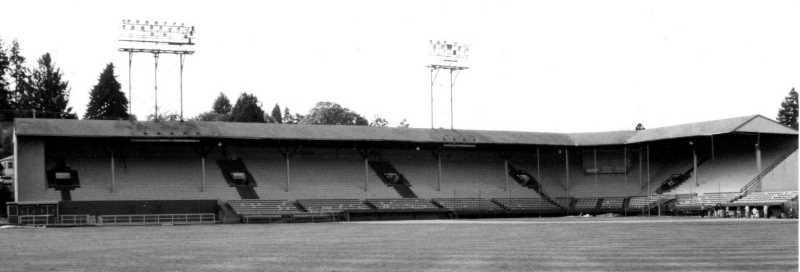
Watch our Trailer (3 min.):
Civic Stadium, beloved by the people of Eugene, Oregon, USA, may not survive much longer. This critically important gathering place integrates the community and connects it to generations of the past and, hopefully, the future. Built in 1938 as a WPA project for community athletic events, Civic Stadium is on the National Register of Historic Places for local and statewide significance and could be upgraded to nationally significant as one of the last wooden grandstands in the US. It is an impressive structure seating 7000 in the heart of south Eugene alongside the old neighborhood of College Hill. It is one of the last places where people of all ages can gather, meet and have fun in a relaxed and secure setting for a low cost. Importantly, in 2009 Civic Stadium, a venerated focus of community recreation in the heart of the city for three generations, lost its main tenant, the Eugene Emeralds baseball club, and now faces an uncertain future and maybe its demise. The Eugene 4J School District, the site owner, has declared the stadium property to be “surplus property” that can be disposed of at their discretion. The school district does not have the funds to renovate Civic. A local community group, Save Civic Stadium, is working hard to develop a plan to save the stadium, but needs all the help it can get. In a preliminary fund-raising phase, SCS has raised (and spent) about $20,000 in community donations, but the needed stadium renovation ultimately will cost at least several million dollars. A $15,000 professional study examining the potential future and uses of the stadium began in April 2010 and the school district in May 2010 will make a key decision about its disposition.
ALI plans to produce a documentary film about Eugene’s Civic Stadium and its place in the history and life of the local community. This is critically important interpretation and a permanent record of a highly significant and unique, as well as threatened, heritage resource for the people of Oregon and the world. Beyond its value in documenting a valued part of the human cultural heritage, our film is a sorely needed catalyst to bring people together to protect and ensure the future of this threatened connection with our past.
Film-making already has begun with the shooting of video and still images capturing activities at baseball games and after the baseball season at the stadium. With the voluntary help of eleven different videographers and photographers and a corps of volunteer support personnel and the assistance of the Eugene Emeralds and Save Civic Stadium, 15-20 fresh hours of video and hundreds of still images are ready for editing together with a wealth of archival footage and stills yet to be compiled. Scores of people, such as long-time residents, former players, announcers, and historians, are ready and available for interviews about the place. Images and sounds from 2009 include many interviews with fans, players, coaches, and owners as well as documentation of the multiplicity of game-night sights and sounds in every part of the stadium. Documentation includes never-before-revealed inscriptions and graffiti from past decades on the walls and benches within the locker rooms and the food-preparation area.
Through the creative energy of ALI film maker Teal Greyhavens, we will combine these elements with archival footage, recordings and stills, interviews with those remembering years gone by, images of other stadiums from other places and times, and historical images of Eugene to tell a story that puts the inanimate structure of the stadium into a meaningful human context. Many information resources are available, including the National Register nomination, a book recently published about the stadium’s history, the Eugene Emeralds baseball club, and archives of The Register-Guard newspaper, the University of Oregon, the Lane County Historical Museum, and local media companies. We plan to produce a primary hour-long version of the film for TV as well as a shorter version for the Web. For us, this is a labor of love as well as a commitment of our professional and technical skills to making a difference for our community.

Many thanks to our volunteers on this project:
Videographers and Photographers
Sal Collura
David Dodson
Kent Goodman
Noah Goodman
Teal Greyhavens
Gabe Guzman
Curtis Hooper
Randi Jacobs
Rick Pettigrew
Guy Prouty
Lucinda Small
Support Staff
Daryl Anderson
Nisha Maulden
Erik Maurer
Jennifer Pettigrew
Web Links:
Civic Stadium (Eugene 4J School District)
Civic Stadium (Wikipedia)
Save Civic Stadium

